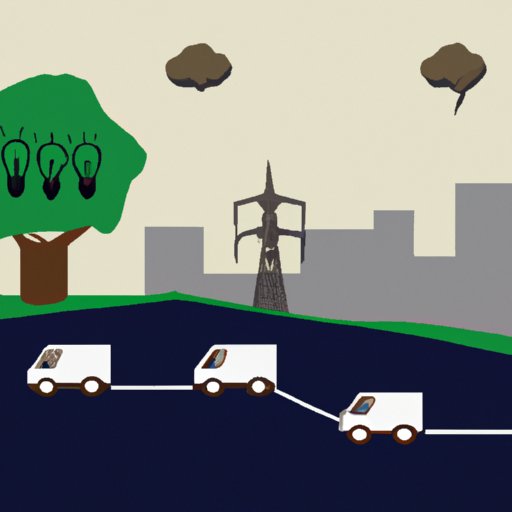Introduction
Pollution is a major environmental issue that has been plaguing the world since the industrial revolution. In its simplest form, it is defined as “the presence of harmful substances or products in the environment.” This can include air, water, and land pollution caused by things such as manufacturing processes, agricultural activities, and transportation. The purpose of this article is to explore effective strategies for tackling the problem of pollution.
Promote Cleaner Energy Sources
One of the most effective strategies for tackling the problem of pollution is to promote cleaner energy sources. Renewable energy sources such as solar, wind, and geothermal power are more environmentally friendly than their non-renewable counterparts, as they do not produce any emissions or pollutants. According to the International Energy Agency, “renewable energy could account for up to 80% of the world’s electricity by 2050.”
Using renewable energy sources has many benefits, including reducing air pollution and greenhouse gas emissions, creating jobs, and providing energy security. It also has the potential to reduce energy costs over the long term. Some examples of renewable energy sources include solar, wind, hydropower, geothermal, and biomass.
Reduce Vehicle Emissions
Another strategy for tackling the problem of pollution is to reduce vehicle emissions. This can be done through the implementation of policies such as emissions standards and fuel efficiency standards. Such policies have been found to be effective in reducing air pollution and improving public health. Additionally, encouraging the use of public transportation or fuel-efficient vehicles can help reduce vehicle emissions.
Using public transportation or fuel-efficient vehicles has many benefits, including reducing air pollution, saving money on fuel costs, and reducing traffic congestion. Additionally, it can help reduce the amount of greenhouse gases released into the atmosphere. It is important to note, however, that these strategies may not be feasible in all areas due to limited access to public transportation or lack of infrastructure.
Increase Recycling
Increasing recycling is another effective strategy for tackling the problem of pollution. Making recycling accessible and convenient for people can encourage them to participate in recycling programs. This can help reduce the amount of waste being sent to landfills, which in turn can reduce air and water pollution.
Recycling also has many other benefits, such as conserving natural resources, saving energy, and creating jobs. Additionally, some materials such as paper, plastic, and metal can be recycled multiple times, further reducing the amount of waste being sent to landfills.
Ban Single-Use Plastics
Banning single-use plastics is another effective strategy for tackling the problem of pollution. Single-use plastics, such as plastic bags, straws, and bottles, are among the most common sources of marine pollution. According to the United Nations Environment Programme, “around 8 million tonnes of plastic end up in our oceans every year.”
Banning single-use plastics can help reduce the amount of plastic ending up in our oceans. Additionally, it can help reduce air and water pollution caused by the production and disposal of plastic. Alternatives to single-use plastics include reusable bags, stainless steel straws, and glass bottles.
Plant Trees
Planting trees is another effective strategy for tackling the problem of pollution. Trees act as natural air filters, as they take in carbon dioxide and release oxygen. Additionally, they can help reduce air pollution by absorbing pollutants such as ozone and particulate matter. According to the World Wildlife Fund, “up to 10 billion trees could be planted to absorb 25 percent of the world’s annual carbon emissions.”
Planting trees also has many other benefits, such as providing habitat for wildlife, conserving soil, and reducing water pollution. Additionally, trees can provide shade, improve air quality, and decrease noise levels. When planting trees, it is important to consider the local climate and choose species that will thrive in the area. Additionally, it is important to ensure that the trees are properly cared for to maximize their environmental benefits.
Educate the Public
Educating the public is an important strategy for tackling the problem of pollution. Raising awareness about the causes and effects of pollution can help encourage people to take action to reduce their own impact. Additionally, campaigns aimed at reducing littering, encouraging the use of reusable products, and promoting sustainable practices can help reduce pollution.
It is also important to provide people with tips for preventing pollution. These can include using public transportation, carpooling, composting food waste, and avoiding single-use plastics. Additionally, people should be encouraged to support companies that are committed to reducing their environmental impact.
Conclusion
In conclusion, there are many effective strategies for tackling the problem of pollution. These include promoting cleaner energy sources, reducing vehicle emissions, increasing recycling, banning single-use plastics, planting trees, and educating the public. Implementing these strategies can help protect the environment and ensure a healthier future for generations to come.
It is clear that tackling the problem of pollution requires collective action. Governments, businesses, and individuals must work together to implement effective strategies and promote sustainable practices. By taking action now, we can ensure a brighter, more sustainable future for ourselves and the planet.
Key Takeaways
- Promote cleaner energy sources such as solar, wind, and geothermal power.
- Reduce vehicle emissions by implementing policies and encouraging the use of public transportation or fuel-efficient vehicles.
- Increase recycling and reduce waste by making it accessible and convenient.
- Ban single-use plastics and provide alternatives.
- Plant trees to reduce air pollution and improve air quality.
- Educate the public about the causes and effects of pollution.
(Note: Is this article not meeting your expectations? Do you have knowledge or insights to share? Unlock new opportunities and expand your reach by joining our authors team. Click Registration to join us and share your expertise with our readers.)
